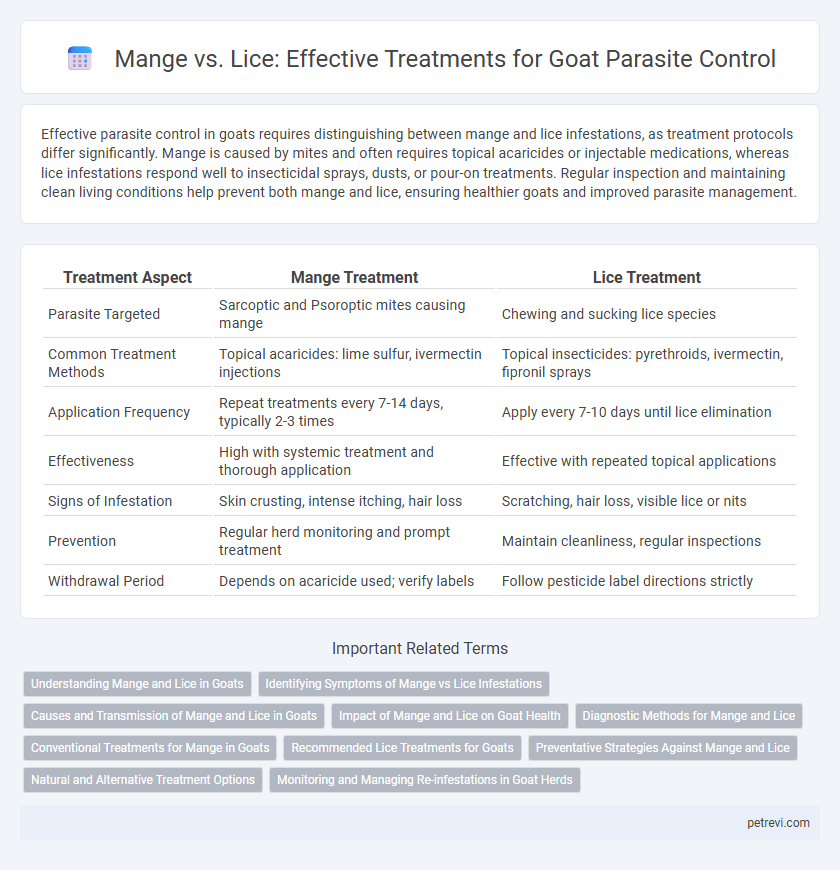Effective parasite control in goats requires distinguishing between mange and lice infestations, as treatment protocols differ significantly. Mange is caused by mites and often requires topical acaricides or injectable medications, whereas lice infestations respond well to insecticidal sprays, dusts, or pour-on treatments. Regular inspection and maintaining clean living conditions help prevent both mange and lice, ensuring healthier goats and improved parasite management.
Table of Comparison
| Treatment Aspect | Mange Treatment | Lice Treatment |
|---|---|---|
| Parasite Targeted | Sarcoptic and Psoroptic mites causing mange | Chewing and sucking lice species |
| Common Treatment Methods | Topical acaricides: lime sulfur, ivermectin injections | Topical insecticides: pyrethroids, ivermectin, fipronil sprays |
| Application Frequency | Repeat treatments every 7-14 days, typically 2-3 times | Apply every 7-10 days until lice elimination |
| Effectiveness | High with systemic treatment and thorough application | Effective with repeated topical applications |
| Signs of Infestation | Skin crusting, intense itching, hair loss | Scratching, hair loss, visible lice or nits |
| Prevention | Regular herd monitoring and prompt treatment | Maintain cleanliness, regular inspections |
| Withdrawal Period | Depends on acaricide used; verify labels | Follow pesticide label directions strictly |
Understanding Mange and Lice in Goats
Mange in goats is caused by microscopic mites that burrow into the skin, leading to intense itching, hair loss, and scabbing, often requiring ivermectin or moxidectin treatments for effective control. Lice infestations involve chewing or sucking lice that live on the goat's hair and skin, causing irritation, restlessness, and anemia in severe cases, with insecticidal sprays or pour-on formulations as common remedies. Accurate diagnosis through skin scraping or parasite identification is essential for targeted treatment, helping prevent resistance and promoting goat health and productivity.
Identifying Symptoms of Mange vs Lice Infestations
Mange in goats is characterized by intense itching, hair loss, scaly skin, and thick crusts, often starting around the face and ears, while lice infestations typically cause constant itching, hair thinning, and small nits attached to the hairs. Mange mites burrow into the skin causing severe irritation and inflammation, whereas lice are external parasites residing on the hair surface, making them easier to spot during close examination. Accurate identification of mites or lice through skin scrapings or visual inspection is essential for selecting effective treatments like ivermectin for mange and insecticidal powders or sprays for lice control.
Causes and Transmission of Mange and Lice in Goats
Mange in goats is caused by microscopic mites that burrow into the skin, leading to intense itching and hair loss, and it spreads primarily through direct contact with infected animals or contaminated environments. Lice infestations arise from wingless parasitic insects that feed on the goat's blood or skin, transmitting through close contact or shared bedding and grooming tools. Both parasites thrive in crowded, unhygienic conditions, making effective parasite management crucial to preventing outbreaks.
Impact of Mange and Lice on Goat Health
Mange and lice infestations in goats cause severe skin irritation, hair loss, and secondary infections, significantly impairing their health and productivity. Mange mites burrow into the skin, leading to intense itching and scab formation, while lice feed on blood or skin debris, causing anemia and weight loss. Effective parasite control through targeted treatments is essential to prevent these conditions from reducing growth rates and milk production in goats.
Diagnostic Methods for Mange and Lice
Diagnostic methods for mange in goats primarily involve skin scraping followed by microscopic examination to detect mites such as Sarcoptes scabiei or Psoroptes ovis. Lice infestations are identified by visual inspection of the hair coat, focusing on areas like the neck, shoulders, and underbelly where lice tend to congregate, often confirmed through magnified examination of collected specimens. Accurate identification of the parasite species through these diagnostic tools is crucial for implementing effective and targeted treatments in goat parasite control programs.
Conventional Treatments for Mange in Goats
Conventional treatments for mange in goats primarily involve the use of topical acaricides such as amitraz, ivermectin, and permethrin, which target and eliminate Sarcoptes scabiei mites responsible for the infestation. These treatments require careful application to affected skin areas and often need repeated doses to break the parasite lifecycle. Effective mange control also includes environmental sanitation and isolating infected animals to prevent re-infestation and spread within the herd.
Recommended Lice Treatments for Goats
Effective lice treatments for goats include topical applications of pyrethrin-based sprays or powders, which target lice and their eggs. Ivermectin injections or pour-on solutions provide systemic control by killing lice throughout the goat's body. Regular treatments every 2 to 4 weeks during infestation periods, combined with environmental cleaning, ensure optimal parasite control.
Preventative Strategies Against Mange and Lice
Effective preventative strategies against mange and lice in goats involve regular inspection and maintaining hygienic living conditions to reduce parasite infestation risks. Implementing rotational grazing and using clean bedding minimize parasite exposure, while topical insecticidal sprays or dips containing permethrin or amitraz provide an early defense barrier. Nutritional support with adequate protein and minerals strengthens the goat's immune system, enhancing resistance against mange mites and lice infestations.
Natural and Alternative Treatment Options
Mange and lice are common external parasites affecting goats, with treatments ranging from chemical insecticides to natural remedies like neem oil and diatomaceous earth, which disrupt parasite exoskeletons safely. Herbal options such as turmeric and garlic have shown antiparasitic properties, boosting goat immunity while minimizing chemical residues in meat and milk. Integrating clean bedding management and rotational grazing enhances the effectiveness of these alternative treatments by reducing parasite reinfestation.
Monitoring and Managing Re-infestations in Goat Herds
Effective monitoring of mange and lice infestations in goats involves regular skin inspections and use of sticky lice traps to detect early parasite presence. Rotating topical treatments such as ivermectin or amitraz with environmental management, including bedding replacement and pasture rotation, minimizes re-infestation risks. Maintaining strict biosecurity measures and quarantining new or affected animals further supports sustained parasite control within goat herds.
Mange vs Lice Treatments for Goat Parasite Control Infographic

 petrevi.com
petrevi.com